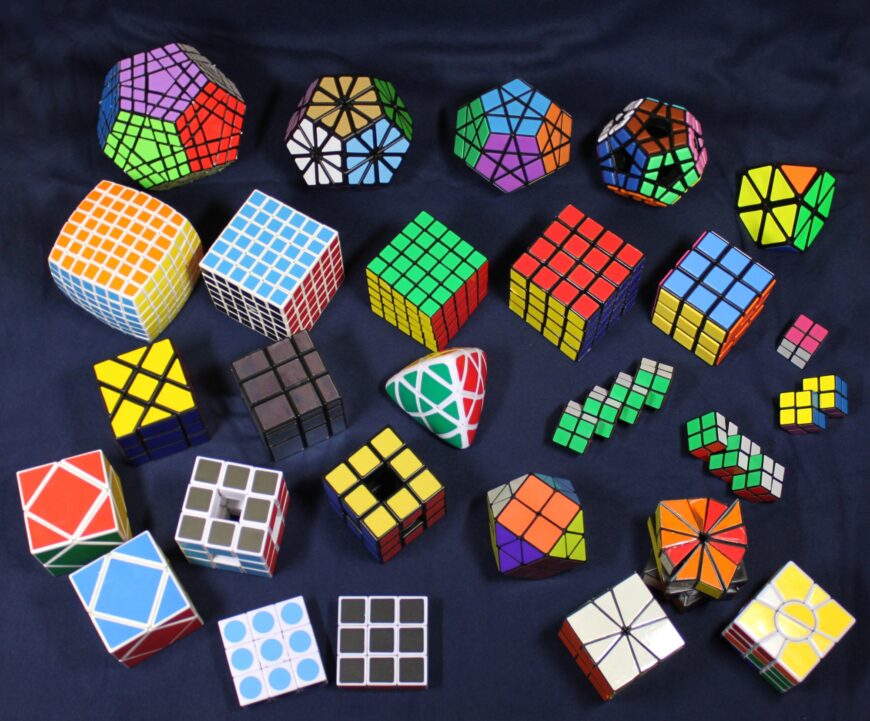How to Get Into Competitive Rubik’s Cubing
October 20, 2022
Rubik’s cube: the three-dimensional, six-sided object that induces fear and panic in the average person who scrambles it and can’t get the cube back to its original, solved state. Whether it’s a 2×2, 3×3, or “the triangle one,” it’s actually much easier than you may think to get into solving Rubik’s cubes. One thing many people don’t know about me is that I can solve a Rubik’s cube, and not just the typical ones that I stated above. Even my closest friends, who have known about this talent for years, are still amazed when I turn the sides of a 3×3 and solve it in under a minute. However, this isn’t that impressive when you get into the competitive side of solving Rubik’s cubes. Though it’s been around for decades, many people have never heard of competitive “cubing.” By now, you probably already have five questions about what I’ve already discussed. But don’t fret: I’m going to tell you all about competitive cubing and the different types of Rubik’s cubes from my personal experiences.
The first thing you need to know about cubing is how a competition works and what to expect. To start off, all official cubing events are run through an organization called the World Cubing Association (WCA). This organization holds events with 100 people to thousands of people around the world. To sign up for a competition, you create an account on the organization’s website and search for nearby events. I’ve personally attended competitions as far as Fairfax, Virginia and Rutgers University, but I’ve also attended competitions as close as Lancaster and Lower Moreland. When you register for an event, there is generally a registration fee that goes towards the usage of the facility where the competition takes place, food that may be sold during downtime, or even a staff member from a well-known cubing store who will sell products throughout the competition. You can sign up for different events, which I will get into later, and during the competition, you get placed into different heats for each category. Your heat determines when you compete in the event. When you judge an event, you time other competitors during their solves and write down their solve times. You also have to be on the lookout for cheating or other problems that might occur. Each competition is different, but depending on your placement, you may get to move on to the next round based on your timed average out of 3 solves. During your heat, you will get called to a solving station 5 times. In between each solve, WCA leaders and members will scramble all of the cubes using a generator and place them into an opaque container. When you get called up to solve your cube, the container is placed upside down so you can’t see the cube and the judge will ask you if you’re ready to look at the cube. Once you say you’re ready, they remove the cover and time 15 seconds in which you are allowed to observe the cube but not make any turns or attempts to solve it. Then when you are done inspecting the cube, you place your hands on a Stackmat timer and release them when the time indicates it’s ready with a green light. Then, the fun part happens, and you get to solve your cube. This entire process repeats until you have your 5 solves. The average time out of 3 solves that I mentioned earlier is calculated by removing your best and worst times and averaging the remaining times.
Now for the more interesting part of this article, the different types of Rubik’s cubes. By now, you may be asking, “But a cube is a square so why is it still called a cube if it’s a different shape?” To be honest, I don’t really know, but I would say “cube” is a more general term. Some of the events in a competition include 3×3, 2×2, pyraminx, skewb, megaminx, blindfold, and square one. Any cube that is named “x by x” refers to the number of squares going across and down the edges of the cube. Pyraminx is “the triangle one,” a skewb has more recently been known to be slightly concave, a megaminx is a 12-sided pentagon, and a square one… well that one’s difficult to explain – just look it up. Like I said earlier, though I can solve a 3×3 in under a minute, it’s actually not that impressive within the cubing community. There are multiple methods on the internet that have been created to cut down on solving times and because of this, national and world records are constantly being broken at competitions. These times can be found for each event on the WCA website. Some of the other cubes that I can personally solve are a 2×2, skewb, pyraminx, megaminx, and a newer cube design called a “redi cube.” All of these cubes come from different brands, in different sizes, are made of different mechanisms and materials, and even come as magnetic or non-magnetic. There have been many interesting advances in Rubik’s cubes in the past 5 or so years.
If you’ve made it this far into the article and I haven’t bored you just yet, I’m going to assume you’d like to know how to solve a Rubik’s cube so you can participate in competitions or just show off to your friends. Unfortunately, I can’t really explain the steps in an article like this, but I can link websites that helped me when I first started learning how to solve a 3×3 and YouTubers I watched that helped me better understand what I was doing. Regardless of whether you wish to enter the cubing community for fun or for the competition, I highly recommend getting into Rubik’s cube solving. Prior to a few weeks ago I actually haven’t touched my Rubik’s cubes in a couple of years, but even after falling out of the hobby for so long, I’ve started to gain interest in it more often. I hope this article has inspired you, and I wish you the best of luck in cracking the secret ways to solve the twisty cube. 🙂
Links:
- World Cubing Association – https://www.worldcubeassociation.org/
- How to Solve a 3×3 (Beginner’s Method) – https://ruwix.com/the-rubiks-cube/how-to-solve-the-rubiks-cube-beginners-method/amp/
- TheCubicle (store) – https://www.thecubicle.com/
- SpeedCubeShop (store) – https://speedcubeshop.com/
- Online Timer (with scrambles) – https://cstimer.net/
YouTubers:
- JRCuber – https://www.youtube.com/c/JRCuber/featured
- DGCubes – https://www.youtube.com/user/DGCubes
- DerpyCuber – https://www.youtube.com/channel/UC0A2GSmPwKC_FE5drWA7vZA
- Hashtag Cuber – https://www.youtube.com/user/hashtagcuber
- Mechanabox – https://www.youtube.com/c/Mechanabox/featured
cyotheking – https://www.youtube.com/user/cyotheking


